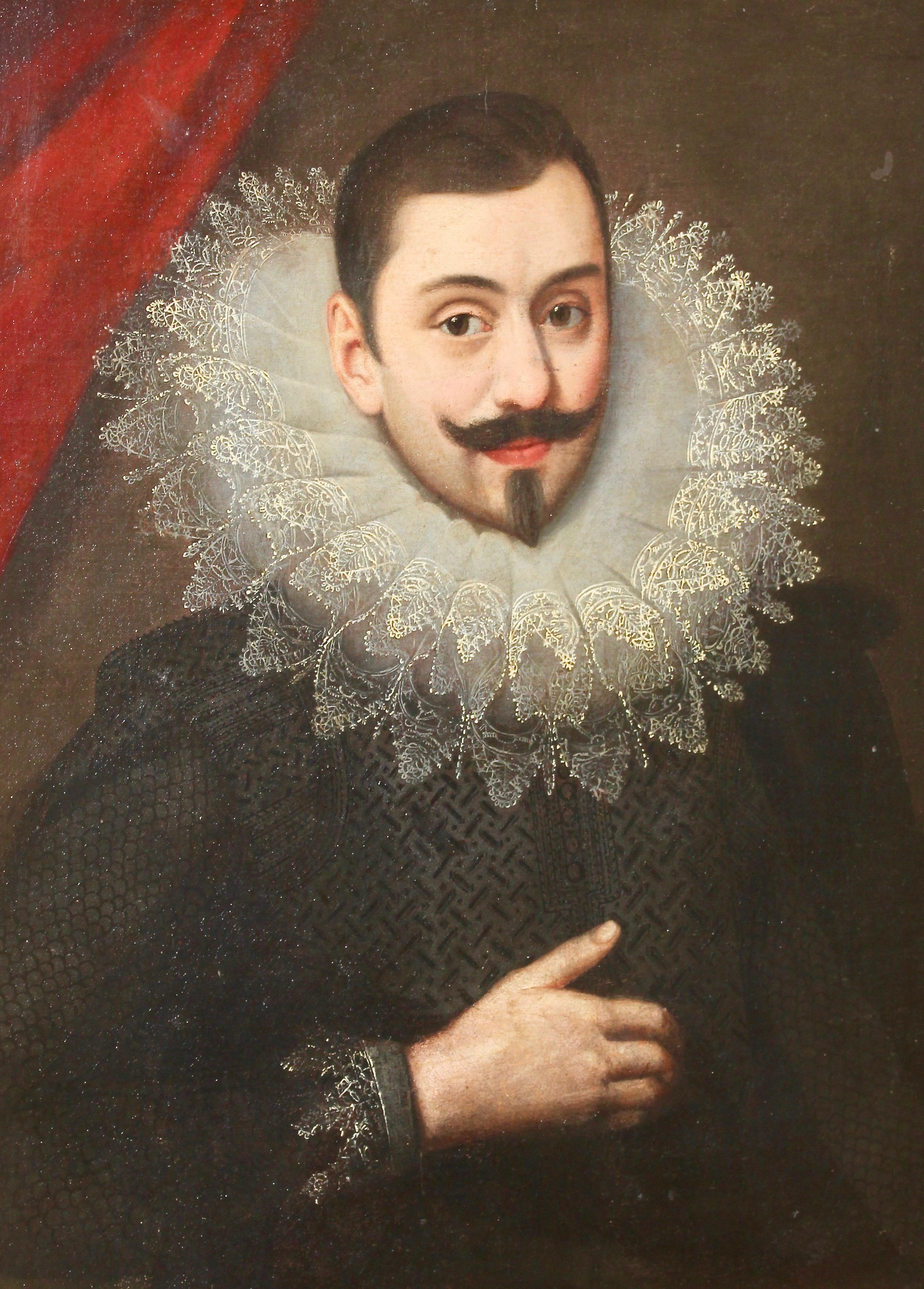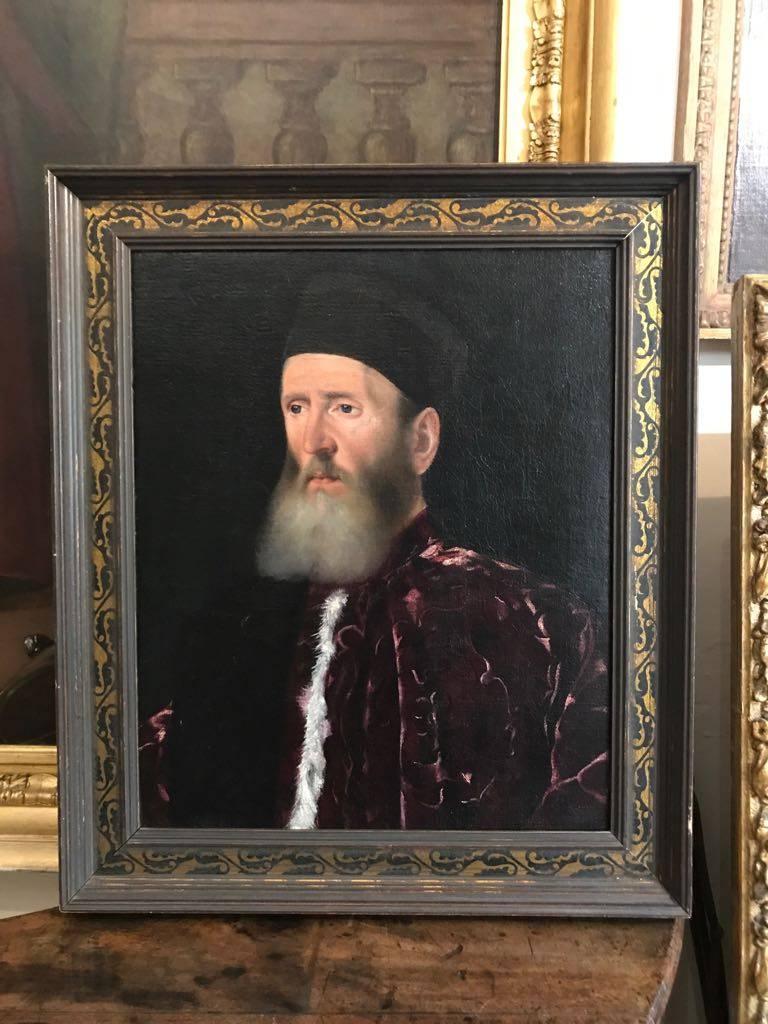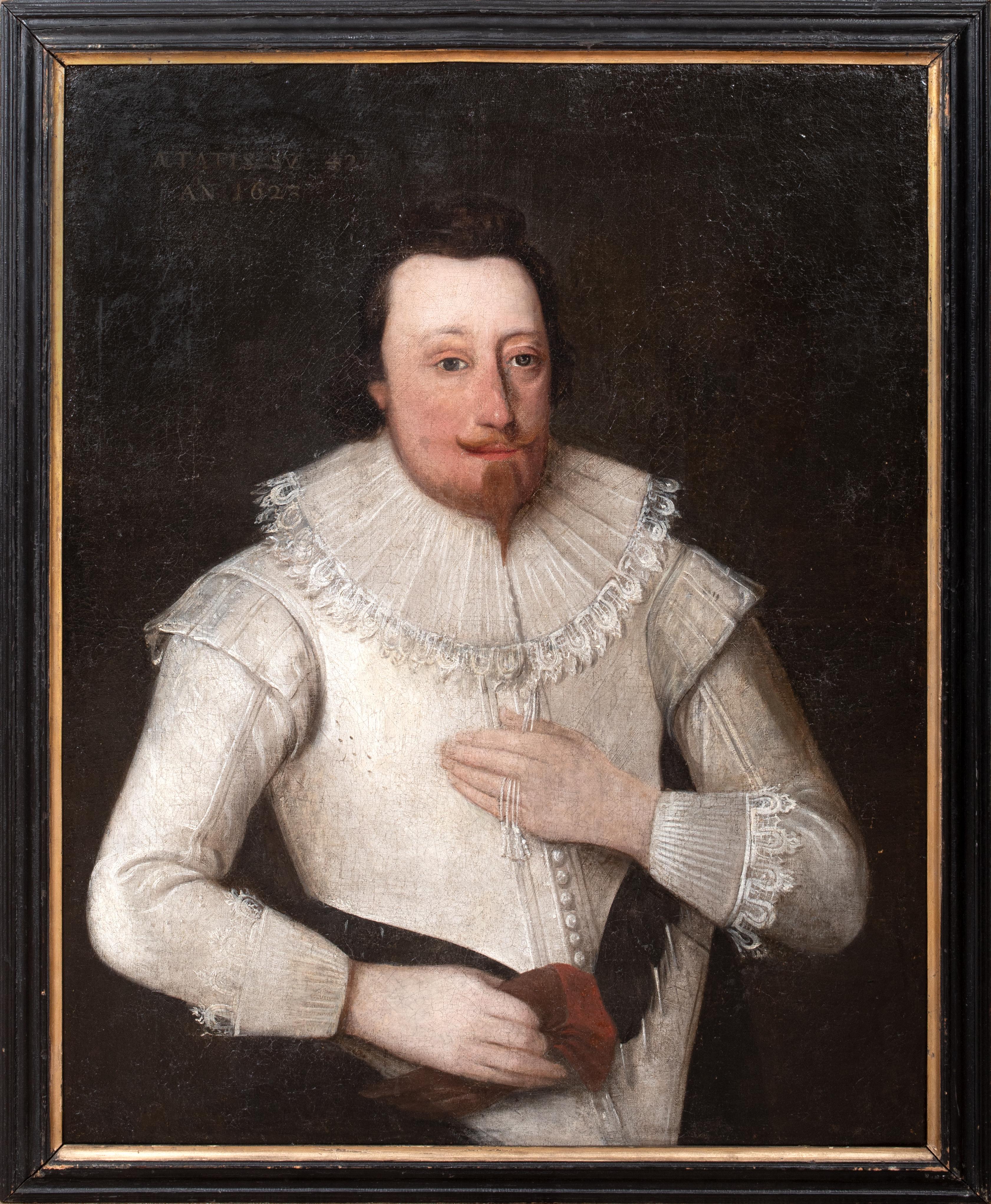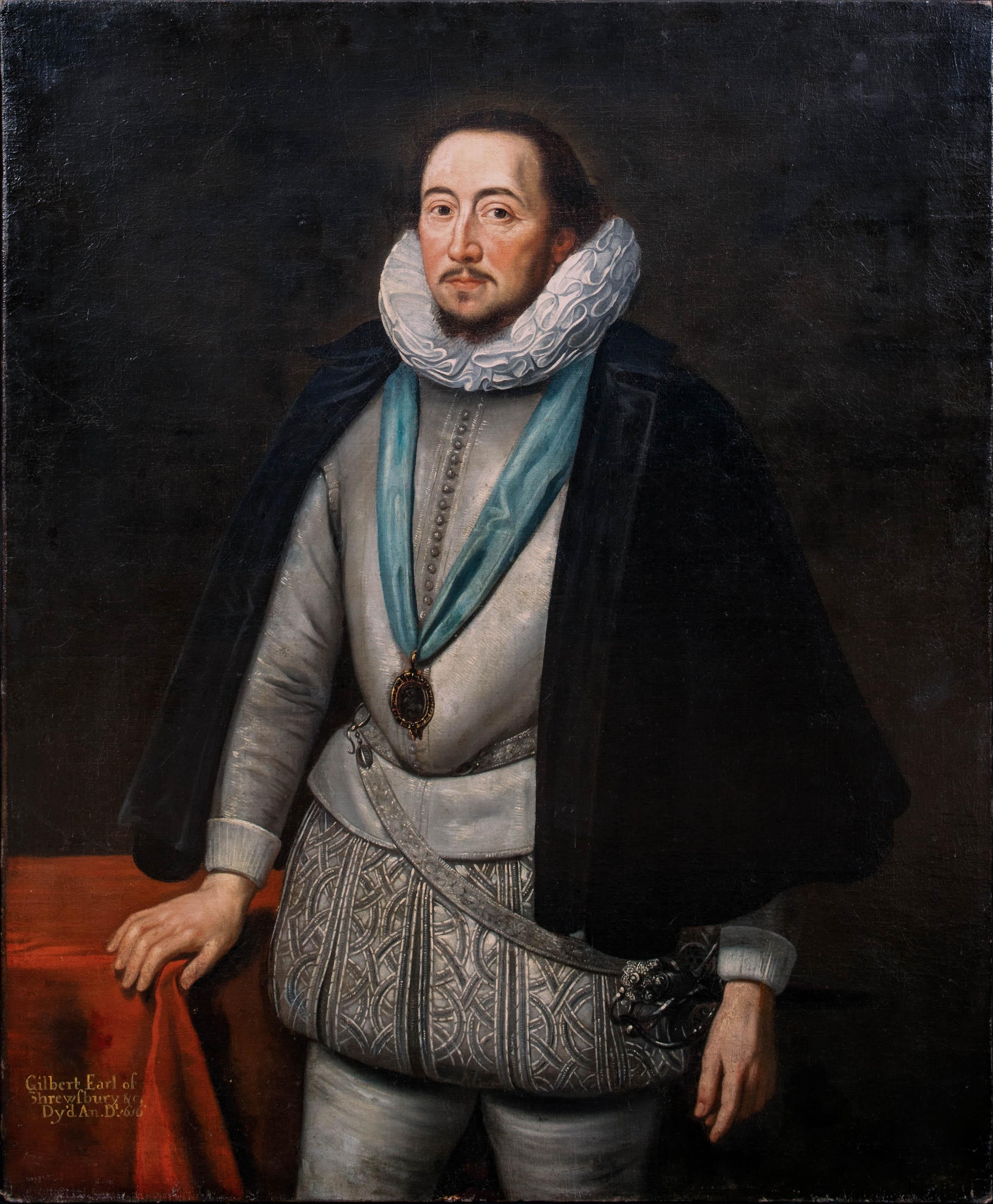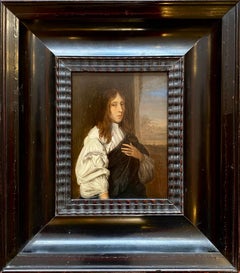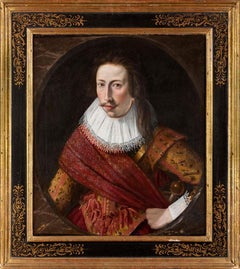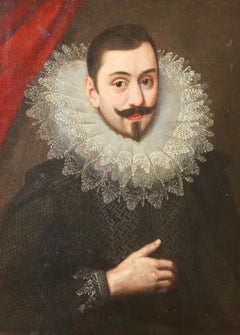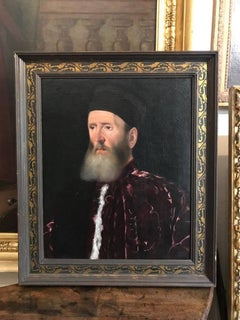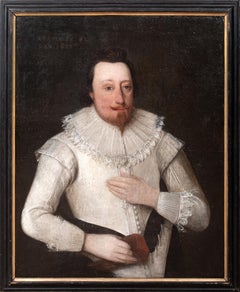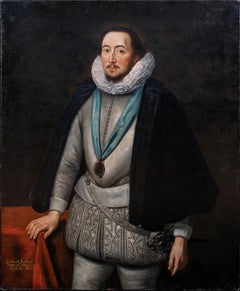Items Similar to Sir Rowland Cotton (1581 – 1634), Tudor Oil on Canvas, Life Size Painting
Want more images or videos?
Request additional images or videos from the seller
1 of 6
Studio of Marcus Gheeraerts the YoungerSir Rowland Cotton (1581 – 1634), Tudor Oil on Canvas, Life Size Painting
$89,359.72
£65,000
€76,149.05
CA$124,582.20
A$135,072.76
CHF 71,183.06
MX$1,642,616.60
NOK 885,630.37
SEK 837,509.35
DKK 568,495.39
About the Item
Oil on original canvas
Image size: 78 1/4 x 44 inches (199 x 112 cm)
Contemporary style frame
Provenance
Sir Rowland Cotton, 1608
Family Descent
Private Collection
Sir Rowland Cotton (1581 – 1634) of Alkington Hall, Whitechurch, and Bellaport Hall, Shropshire.
The doublet he is wearing is now in the Victoria and Albert Museum. Kept in the family and then bequeathed to the Museum.
Rowland was born in 1581, Crooked Lane, St Michael’s, London, just two streets away from Pudding Lane where the Great Fire of London would start, years later in 1666. In the proceedings in the Court of Request files William Cotton is listed with a request relating to tenements in St Clement’s Lane, Cannon Street and the parish of St. Michael, Crooked Lane, London. When Rowland and his brother William were very young they were educated by a family friend and lodger Hugh Broughton.
In 1596, Rowland went to study at St John’s College Cambridge. When he was 18 years old he was admitted to Lincoln’s Inn, Holborn, London. When Rowland was 22 years old, he became a courtier to Prince Henry Frederick.
On the 3rd March 1605, aged 24, Rowland married Frances Needham of Shavington Hall at St. Mary Magdelen Church, Milk Street, London. Frances was the daughter of Robert Needham, 1st Viscount Kilmorey, of Shavington Hall.
Following the death of Sir John Bowyer in 1605, Rowland was elected as MP for Newcastle under Lyme. Rowland would have been in the House of Commons for the opening of Parliament on the 5th November and if the Gun Powder Plot had succeeded he would most likely have lost his life.
Aged 25, Rowland’s wife Frances died shortly after giving birth to their daughter, who also died on the same day, 23rd November 1606.
When William Cotton, Rowland’s father died, calling himself a Citizen and Draper of London, in his Will he gave all of his lands and property in the counties of Shropshire and Staffordshire to his eldest son Rowland Cotton.
13th November 1608 – Rowland Cotton is knighted at Whitehall.
In 1609 Rowland commissioned Inigo Jones to design a monument for his late wife Frances Cotton. It is around this time that Inigo was also producing drawings for the New Exchange in the Strand and the central tower of St Paul’s Cathedral. Inigo’s original design would later be adapted to include Rowland, beside Frances and their child. In 1610, now aged 29 Rowland took part in ‘Prince Henry’s Barriers’. Barriers was a stylized martial combat, conducted on foot with swords and pikes; it was like jousting without horses. This elaborate indoor tournament was preceded by a theatrical entertainment known as a masque. Masques were vastly expensive performances, staged just once, in which scenes whose aim was the glorification of the Stuart dynasty were acted out by courtiers and members of the royal family. Written by playwright Ben Jonson, it was accompanied by music and dance performed by magnificently costumed participants on spectacular sets designed by the court architect Inigo Jones. The prince himself commissioned Oberon, the Faery Prince, for the Christmas celebrations in 1610–11; he took the lead role, and was presented as an amalgamation of Roman hero and Arthurian knight.
On the 22nd August 1634, aged 53, Sir Rowland Cotton died.
This portrait transports us back to the grandeur and opulence of Jacobean England. The subject stands proudly dressed in exquisite court attire, he epitomises the elegance and refinement that characterised this era. The artist's meticulous attention to detail is evident in every aspect of this masterpiece. From the elaborate collar to his finely crafted shoes, no element has been overlooked. As one explores its intricate details and vibrant colours, it becomes clear that this portrait was not simply meant for private admiration but also served as a symbol of status and power.
In the top right hand corner there is a small window depicted, that shows the house and surrounding grounds that we can assume is owned by the gentleman's family. There is also a latin emblem - 'nec somnolentus, nec officiosus' which roughly translates as 'neither sleepy or dutiful'. Whilst to a modern ear this seems a peculiar saying, at the time it would have perfectly described a balanced and equable person who could be steadily relied upon.
By the middle of the decade, the collar now appears weightless. He lifts his shoulders which he lets appear. This is the collar montage, a starched collar mounted on a metal frame. This is the main novelty and characteristic of the 1600s: the collar is suspended.
Credit to Hannah Hague, The History Detective.
Marcus Gheeraerts the Younger
Marcus Gheeraerts was born in Bruges in 1561 or 1562, and was brought to England in 1568 by his father, a painter of whose work hardly anything is known. Trained by his father and perhaps also a pupil of Lucas de Heere, Marcus produced his first surviving inscribed portrait in 1593; by this date, however, he was already under the powerful patronage of the royal pageant master, Sir Henry Lee. In 1590 Gheeraerts married Magdalena, the sister of the painter John De Critz. The couple had six children, only two of whom seemed to have survived.
Gheeraerts was the most distinguished and most fashionable portraitist of the 1590s, and continued to be after Elizabeth's death, becoming the favorite painter of James I's queen, Anne of Denmark. He received a grant of naturalization in 1618, and was still royal "picture drawer" in that year, when he received his last recorded payments for royal portraits. During the second half of the 1610s, however, Gheeraert's position declined as the result of competition from a new generation of immigrants. For the last twenty years of his life he was supported chiefly by the lesser gentry and by academic sitters. Gheeraerts was a member of the Court of the Painter-Stainers' Company in the 1620s and had an apprentice, Ferdinando Clifton, who was made free of the Company in 1627. Gheeraerts died on 19 January 1636.
- Creator:Studio of Marcus Gheeraerts the Younger (1561 - 1636, English)
- Dimensions:Height: 78.25 in (198.76 cm)Width: 44 in (111.76 cm)
- More Editions & Sizes:1 of 1Price: $58,702
- Medium:
- Movement & Style:
- Period:
- Condition:
- Gallery Location:London, GB
- Reference Number:1stDibs: LU52414412192
About the Seller
5.0
Vetted Professional Seller
Every seller passes strict standards for authenticity and reliability
Established in 2007
1stDibs seller since 2014
84 sales on 1stDibs
Typical response time: 2 hours
- ShippingRetrieving quote...Shipping from: London, United Kingdom
- Return Policy
Authenticity Guarantee
In the unlikely event there’s an issue with an item’s authenticity, contact us within 1 year for a full refund. DetailsMoney-Back Guarantee
If your item is not as described, is damaged in transit, or does not arrive, contact us within 7 days for a full refund. Details24-Hour Cancellation
You have a 24-hour grace period in which to reconsider your purchase, with no questions asked.Vetted Professional Sellers
Our world-class sellers must adhere to strict standards for service and quality, maintaining the integrity of our listings.Price-Match Guarantee
If you find that a seller listed the same item for a lower price elsewhere, we’ll match it.Trusted Global Delivery
Our best-in-class carrier network provides specialized shipping options worldwide, including custom delivery.More From This Seller
View AllPortrait of King Edward VI, Oil on panel with Gold Leaf, 18th Century English
Located in London, GB
Oil on oak panel
Image size: 25 1/2 x 19 inches (37.5 x 27 inches)
18th Century Auricular gilt frame
Provenance
New York private collection
This portrait of the King Edward VI depicts the boy-king standing in a black and gold embroidered doublet, wearing a jewelled cap. King Edward holds a staff with a globus cruciger set on the table beside him. No expense has been spared in the making of this piece, with gold leaf being applied in many areas to give the effect of the costume's gold embroidery, chain of office and other metal accessories.
As the precious male heir to the Tudor dynasty...
Category
Early 18th Century English School Portrait Paintings
Materials
Gold Leaf
Portrait of Nicholas Poyntz
Located in London, GB
Remigius Van Leemput
Portrait of Nicholas Poyntz
1607-1675
Oil on oak panel, unsigned
Image size: 13 x 10 1/4 inches (33 x 26 cm)
Contemporary style frame
Provenance
The Dalva Brot...
Category
17th Century Flemish School Portrait Paintings
Materials
Oil, Panel
Portrait of a Young Man - 17th Century Portrait in Oil
By Pieter Harmensz Verelst
Located in London, GB
Circle of Pieter Harmensz Verelst
1618 - 1678
Portrait of a Young Man
Oil on oak panel
Image size: 7 ½ x 5 ¾ inches
Dutch ripple frame
Category
18th Century and Earlier Old Masters Portrait Paintings
Materials
Oil, Panel
Portrait of an Officer, Cornelius Johnson, 17th Century Old Masters
By Cornelius Johnson
Located in London, GB
Circle of Cornelius Johnson
Circa 1620’s
Portrait of a Officer
Oil on canvas
Image size: 28 x 24 inches
Period style hand made frame
Provenance
Private European Estate
This striking portrait dates to around 1620, as you can see from the images of the sash the detail is very high. The sash is decorated with gold thread and would have cost a small fortune at the time. Sashes were originally developed for a military function (making officers more visible for their men during combat), but soon became a primarily male fashion...
Category
Early 17th Century Old Masters Portrait Paintings
Materials
Oil
Portrait of William Herbert, 3rd Earl of Pembroke, Early 17th Century Portrait
Located in London, GB
English School, (circa 1600)
Portrait of William Herbert, 3rd Earl of Pembroke
Oil on panel, oval
Image size: 29¼ x 23⅞ inches
Painted wooden frame
Provenance:
176, Collection of Francis Greville, 1st Earl of Warwick.
The Trustees of the Lord Brooks’ Settlement, (removed from Warwick Castle).
Sotheby’s, London, 22nd March 1968, lot 81.
Painted onto wooden panel, this portrait shows a dark haired gentleman in profile sporting an open white shirt. On top of this garments is a richly detailed black cloak, decorated with gold thread and lined with a sumptuous crimson lining. With the red silk inside it’s all very expensive and would fall under sumptuary laws – so this is a nobleman of high degree.
It’s melancholic air conforms to the contemporary popularity of this very human condition, evident in fashionable poetry and music of the period. In comparison to our own modern prejudices, melancholy was associated with creativity in this period.
This portrait appeared in the earliest described list of pictures of Warwick castle dating to 1762. Compiled by collector and antiquary Sir William Musgrave ‘taken from the information of Lord & Lady Warwick’ (Add. MSS, 5726 fol. 3) is described;
‘8. Earl of Essex – an original by Zuccharo – seen in profile with black hair. Holding a black robe across his breast with his right hand.’
As tempting as it is to imagine that this is a portrait of Robert Devereux, the 2nd Earl Essex, we might take this with a pinch of salt. Its identification with this romantic and fatal Elizabethan might well have been an attempt to add romance to Warwick Castle’s walls. It doesn’t correspond all that well with Essex’s portraits around 1600 after his return from Cadiz. Notably, this picture was presumably hung not too far away from the castle’s two portraits of Queen Elizabeth I. The first, and undoubtedly the best, being the exquisite coronation portrait that was sold by Lord Brooke in the late 1970s and now hangs in the National Portrait Gallery. The second, described as being ‘a copy from the original at Ld Hydes’, has yet to resurface.
The portrait eventually ended up being hung in the State Bedroom of Warwick Castle.
Archival documents present one other interesting candidate. The Greville family’s earliest inventory of paintings, made in 1630 at their home Brooke House in Holborn, London, describes five portraits of identified figures. All five belonged to the courtier, politician and poet Sir Fulke Greville (1554-1628), 1st Baron Brooke, and were hung in the ‘Gallerie’ of Brooke House behind yellow curtains. One of them was described as being of ‘Lord of Pembrooke’, which is likely to have been William Herbert (1580-1630), 3rd Earl of Pembroke. William was the eldest son of Greville’s best friend’s sister Mary Sidney, and was brought up in the particularly literary and poetically orientated household which his mother had supported. Notably, the 3rd Earl was one of the figures that Shakespeare’s first folio was dedicated to in 1623.
The melancholic air to the portrait corresponds to William’s own pretensions as a learned and poetic figure. The richness of the robe in the painting, sporting golden thread and a spotted black fabric, is indicative of wealth beyond that of a simple poet or actor. The portrait’s dating to around the year 1600 might have coincided with William’s father death and his own rise to the Pembroke Earldom. This period of his life too was imbued with personal sadness, as an illicit affair with a Mary Fitton had resulted in a pregnancy and eventual banishment by Elizabeth I to Wilton after a short spell in Fleet Prison. His illegitimate son died shortly after being born. Despite being a close follower of the Earl of Essex, William had side-stepped supporting Devereux in the fatal uprising against the Queen and eventually regained favour at the court of the next monarch James I.
His linen shirt is edged with a delicate border of lace and his black cloak is lined on the inside with sumptuous scarlet and richly decorated on the outside with gold braid and a pattern of embroidered black spots.
Despite the richness of his clothes, William Herbert has been presented in a dishevelled state of semi-undress, his shirt unlaced far down his chest with the ties lying limply over his hand, indicating that he is in a state of distracted detachment. It has been suggested that the fashion for melancholy was rooted in an increase in self-consciousness and introspective reflection during the late 16th and early 17th centuries.
In contemporary literature melancholy was said to be caused by a plenitude of the melancholy humor, one of the four vital humors, which were thought to regulate the functions of the body. An abundance of the melancholia humor was associated with a heightened creativity and intellectual ability and hence melancholy was linked to the notion of genius, as reflected in the work of the Oxford scholar Robert Burton, who in his work ‘The Anatomy of Melancholy’, described the Malcontent as ‘of all others [the]… most witty, [who] causeth many times divine ravishment, and a kind of enthusiamus… which stirreth them up to be excellent Philosophers, Poets and Prophets.’ (R. Burton, The Anatomy of Melancholy, London, 1621 in R. Strong, ‘Elizabethan Malady: Melancholy in Elizabethan and Jacobean Portraits’, Apollo, LXXIX, 1964).
Melancholy was viewed as a highly fashionable affliction under Elizabeth I, and her successor James I, and a dejected demeanour was adopted by wealthy young men, often presenting themselves as scholars or despondent lovers, as reflected in the portraiture and literature from this period. Although the sitter in this portrait is, as yet, unidentified, it seems probable that he was a nobleman with literary or artistic ambitions, following in the same vain as such famous figures as the aristocratic poet and dramatist, Edward de Vere...
Category
Early 17th Century Old Masters Portrait Paintings
Materials
Oil, Wood Panel
Portrait of a Man, 17th Century Dutch Oil on Panel Portrait
By Cornelis Dusart
Located in London, GB
Circle of Cornelis Dusart
Dutch 1660 - 1704
Portrait of a Man
Oil on panel
Image size: 7¾ x 5¼ inches
Giltwood frame
Cornelis Dusart
Cornelis ...
Category
17th Century Old Masters Portrait Paintings
Materials
Oil, Panel
You May Also Like
Antique Flemish Baroque painting, 17th Century Portrait "Medici" Oil on canvas.
By Justus Sustermans
Located in Berlin, DE
Antique Flemish Baroque painting, 17th century, portrait, Medici. Oil on canvas.
The painting is probably attributed to the Flemish painter Justus Sustermns.
Pictured is most likel...
Category
17th Century Baroque Portrait Paintings
Materials
Canvas, Oil
$21,545 Sale Price
25% Off
Free Shipping
16th Century Italian Renaissance Old Master Portrait of a Procuratore
By Jacopo Bassano
Located in London, GB
Jacopo BASSANO (c. 1510-1592, Italian)
Portrait of a Procuratore
Oil on canvas
30 ¼ x 26 inches (including frame)
Provenance: Lucien Bonaparte’s Collection (as Portrait of Doge Priuli, Tiziano); Rich-mond, Virginia Museum, Portrait of Doge Lorenzo Priuli.
The painting is a portrait of a man half-length, on a black background. It is a three-quarter portrait, according to a custom very common in the genre of portraiture in sixteenth century. The man is wearing a decorated...
Category
16th Century Old Masters Portrait Paintings
Materials
Oil
$241,958 Sale Price
20% Off
Free Shipping
Portrait Of A Gentleman, identified as Robert Carr, Earl Of Somerset (1587-1645)
Located in Blackwater, GB
Portrait Of A Gentleman, identified as Robert Carr, Earl Of Somerset (1587-1645), 17th Century
English Court Portrait dated 1625
Large 17th Century English Court Portrait, possibly...
Category
17th Century Portrait Paintings
Materials
Canvas, Oil
$6,598 Sale Price
20% Off
Portrait Of Gilbert Talbot 7th Earl of Shrewsbury (1552-1616), 16th Century
Located in Blackwater, GB
Portrait Of Gilbert Talbot 7th Earl of Shrewsbury (1552-1616), 16th Century
Circle of George Gower (c.1540–1596)
Huge 16th Century Portrait Of Gil...
Category
18th Century Portrait Paintings
Materials
Canvas, Oil
$16,451 Sale Price
20% Off
Portrait Gentleman Armor Carbone Van Dyck Paint Oil on canvas 17th Century Italy
Located in Riva del Garda, IT
Giovanni Bernardo Carbone (Genoa, 1616 - 1683), workshop
Portrait of a gentleman in armor with battle scene in the background
Oil on oval canvas (117 x 105 cm. - In gilded frame 124...
Category
17th Century Old Masters Paintings
Materials
Oil
$8,589 Sale Price
20% Off
Portrait of a Gentleman in Doublet & Ruff c.1595; Elizabethan oil on copper
Located in London, GB
Portrait of an Elizabethan Gentleman in a Black Doublet c.1595
Manner of Hieronimo Custodis (died c.1593)
Oil on copper
Unsigned
This exquisite oil on copper portrait, painted around 430 years ago, is a splendid survival from the Elizabethan era - the golden age in England’s history, when Queen Elizabeth I was on the throne. It is a time that is sandwiched between two golden ages of English renaissance culture, the reigns of Henry VIII and Charles I. This period produced a style of painting quite unlike that anywhere else in Europe and one that deserves serious assessment. Just a couple of years after our portrait was painted, English painting developed on another course, driven mainly by the artists Marcus Gheeraerts the Younger and Isaac Oliver; they depicted a new mood that was pervading Elizabethan and Jacobean society, which was that of romantic melancholy. Elizabethan painting...
Category
16th Century Old Masters Portrait Paintings
Materials
Copper
More Ways To Browse
Portrait Of Queen Elizabeth I
Portrait Of A Young Gentleman
St John College
James Denmark
Life Size Painting
Small Antique Windows
Antique St Michael
Antique Dress Stand
17th Century Portrait Of A Gentleman
Frederick Prince
Robert Daughters
John Rowlands
Tudor Painting
Tudor Oil Painting
John De Critz
Egyptian Oil Painting
German Abstract Expressionism
Glamour Paintings
